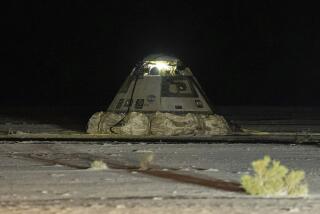Space Center Triumph Turns to Tragedy
HOUSTON — There were about a dozen of us--visiting reporters and NASA public affairs officers--watching the two big closed-circuit television screens showing the liftoff of Challenger.
There were the usual cheers, ours and those of the technicians and controllers in the nearby command central at Johnson Space Center, for the spectacle of liftoff.
Then, with Challenger rising into the sky, the screens showed a close-up of a large explosion.
“That’s the booster,” someone near me said.
“God, that was awful big,” someone added.
Then, it began to dawn on us that we were seeing triumph turn to tragedy.
“Oh, my God!” exclaimed Billie Dason, one of the NASA public relations people. “Is that booster rocket pieces falling away?”
Another NASA spokeswoman, a veteran of many space shuttle liftoffs, was the first to say it:
“Oh, my God!” she half-cried. “That’s the capsule, that’s the crew capsule!”
All of us were thinking the unthinkable now.
NASA specialist Faye Carlton put it in words: “The capsule, it’s exploded!”
“Do we have a downlink?” someone else said urgently. “Do we have a downlink?”
There was no answer, but one of the National Aeronautics and Space Administration people shook his head.
I am not a space shuttle expert, I’m an urban affairs writer, and I was here on a story about a future space station. But I knew what downlink meant--communication with the crew.
There was an eerie silence. Then, the phones in the press room started ringing.
In the utter horror of it all, a couple of NASA people just collapsed, pale, shaken; others were in tears.
About five minutes later, the public affairs experts began answering the phones, saying: “Yes, yes, it’s true.”
Someone said: “Seven are gone, they’re all gone.”
More to Read
Sign up for Essential California
The most important California stories and recommendations in your inbox every morning.
You may occasionally receive promotional content from the Los Angeles Times.










